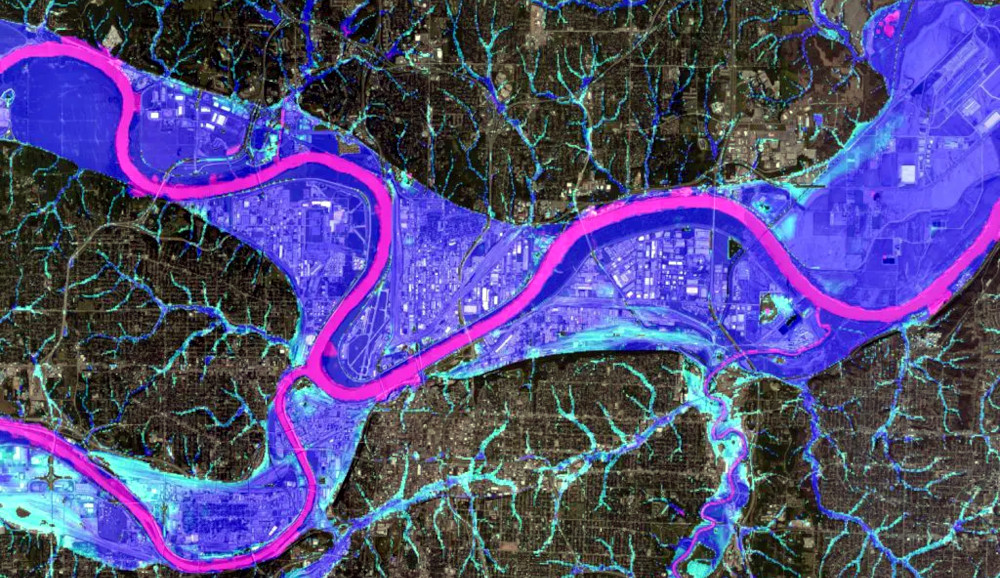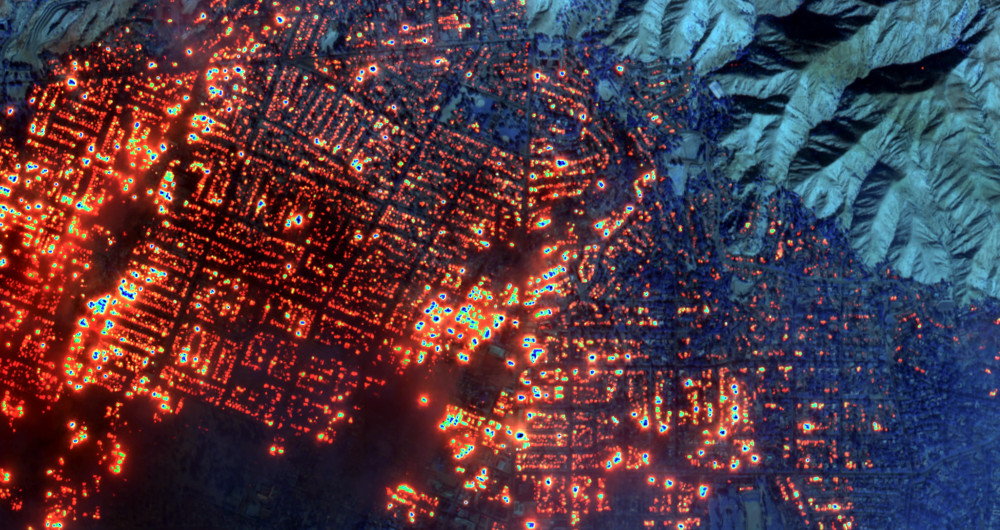Establishing new homes in disaster hazard zones could value billions, threaten affordability
 Image credit score rating: Fathom
Image credit score rating: Fathom
Worldwide
As is the case in most developed worldwide places, governments all through Canada are
racing to assemble additional housing to boost affordability. However a model new study from the
Canadian Native climate
Institute
has found these efforts risk putting an entire lot of 1000’s of homes in damage’s
method — and together with billions of {{dollars}} in costs yearly — besides protection is
improved to direct enchancment away from the specter of wildfires and floods.
As Close to Dwelling: The suitable approach to assemble additional housing in a altering
native climate
outlines, developing new homes in areas at a extreme risk of flood or wildfire could
value governments, insurers and house owners as a lot as $3 billion additional yearly for
rebuilding and disaster help. These risks are neither distant nor abstract:
Damages from merely 4 extreme-weather events in July and August 2024 —
flooding
in Toronto and Southern Ontario, the catastrophic
wildfire
in Jasper, extreme
flooding
in Quebec and an historic
hailstorm
in Calgary — totaled higher than $7 billion in insured
losses.
One of many essential putting findings of the study is that plenty of the projected
costs are associated to a relatively small number of homes anticipated to be
in-built flood-vulnerable zones: Redirecting merely three % of newest homes
away from the highest-risk flood areas could save virtually 80 % of all
projected weather-related losses by 2030.
“Basically probably the most cheap home is the one you should not have to rebuild after a disaster.
Governments all through Canada can save billions of {{dollars}} yearly and protect people
protected against disasters by developing solely a small proportion of newest homes away from
the highest-risk areas for wildfires and floods,” says Ryan
Ness, Director of Adaptation
on the Canadian Native climate Institute. “Our new report outlines the devices
policymakers must steer new housing to safer flooring and help affordability
inside the course of.”
The report — which contains wildfire-risk analysis from Canadian financial
corporations company Co-operators, flood-risk modeling
by Fathom Worldwide and future housing risk analysis
by SSG — is a first-of-its-kind analysis in Canada to model
the financial costs of future floods and fires on new housing slated for
constructing by 2030.
It finds that higher than 540,000 homes could very properly be in-built areas of flood hazard
and higher than 220,000 homes in locations uncovered to extreme wildfire hazards by
2030. The associated full costs usually tend to be highest in British
Columbia — which faces $2.2 billion in added annual costs beneath a worst-case
state of affairs — adopted by Manitoba ($360 million), Alberta ($220
million), and Quebec ($214 million). The Yukon may even see will improve in
frequent damages as extreme as $1,200 for each new dwelling from flooding alone, successfully
previous the nationwide frequent.
The Native climate Institute moreover commissioned a companion report, Indigenous
Housing and Native climate
Resilience,
by Shared Value
Choices
to ascertain distinctive challenges and obstacles confronted by Indigenous Nations in
rising climate-resilient homes, with a particular focus on housing on First
Nations reserves. The report examines worthwhile insurance coverage insurance policies and practices, and
presents 9 protection strategies.
“Fixing Canada’s housing catastrophe requires not merely developing additional homes nonetheless
making sure they’re cheap in the long term. This accommodates developing new homes
in protected locations which may be resilient to increasingly more excessive floods and
wildfires,” asserts Lisa Raitt,
Vice-Chair of Worldwide Funding Banking at
CIBC and Co-Chair of the Exercise Stress for
Housing and Native climate. “This new Native climate Institute
report highlights the financial risks Canada faces if housing protection continues
to allow harmful enchancment, and affords actionable choices to protect people
and property.”
The report notes that each one ranges of presidency have a job to play in decreasing
the threats of most local weather disasters to new homes, and affords these protection
strategies:
-
Federal, provincial and territorial governments must steer housing and
infrastructure funding away from high-hazard zones to low-hazard areas. -
Provincial and territorial governments must strengthen land use protection to
redirect new constructing away from areas at extreme risk of flood and fireside
damage. -
Federal, provincial and territorial governments must reform
disaster-assistance packages to discourage harmful enchancment — as an example, by
making new homes in-built high-hazard zones ineligible for publicly funded
disaster compensation. -
Governments must create, protect and make publicly on the market maps that
current hazardous areas — and mandate the disclosure of such knowledge in
precise property transactions — so that house owners, renters and builders have
entry to that info. -
The federal authorities must empower and help Indigenous communities to
assemble climate-resilient
homes
in safer areas inside their territories.
“Native governments, on the forefront of every the native climate and housing crises, are
vital companions in safeguarding Canadians and defending communities from
escalating native climate impacts,” says Carole
Saab, CEO of Federation of Canadian
Municipalities. “This report highlights the urgency of coordinating all through all
orders of presidency and sectors to take care of Canadians and their homes protected against
increasingly more excessive wildfires and floods.”
Native weather-driven migration, insurance coverage protection will improve could erase $1.4T in US precise property price by 2055
 The LA fires, January 2025 | Image credit score rating: Maxar
The LA fires, January 2025 | Image credit score rating: Maxar
Within the meantime, First Avenue’s just-released twelfth
nationwide report estimates a doable $1.47 trillion low cost in US precise
property price over the following 30 years ensuing from climate-related risks.
First Avenue makes use of clear, peer-reviewed methodologies to quantify the earlier,
present and future native climate risk for properties globally and makes it on the market
for residents, enterprise and authorities. In October, Zillow began offering
First Avenue’s data for five key climate-related
risks
on all for-sale property listings all through the US — serving to patrons to raised
assess long-term affordability and plan for the long term.
Drawing on interdisciplinary evaluation that examines native climate risk consciousness,
housing market dynamics, native climate migration patterns, and demographic and
socioeconomic shifts, First Avenue’s new Property Prices in
Peril report
affords a forward-looking analysis of the Housing Value
Index,
property-valuation developments and localized GDP impacts extending to 2055.
Key findings
-
By 2055, climate-driven local weather phenomena are anticipated to increase home-owner
insurance coverage protection premiums nationwide by a median of 29.4 % — the 5
largest metro areas going by the most effective insurance coverage protection premium will improve are Miami
(322 %), Jacksonville (226 %), Tampa (213 %), New Orleans
(196 %), and Sacramento (137 %). -
Concurrently, migration induced by native climate risks along with extreme heat,
wildfire and flooding is anticipated to drive vital inhabitants
redistribution, with 55 million Folks anticipated to relocate all through the US
over the equivalent interval to historically a lot much less populous states harking back to North
Dakota and Montana — which might be forecasted to develop ensuing from their native climate
resilience.
“Native climate change just isn’t a theoretical concern; it is a measurable strain
reshaping precise property markets and regional economies all through the US,”
acknowledged Dr. Jeremy Porter, Head of
Native climate Implications Evaluation at First Avenue. “Our findings highlight the
urgent wish to know the way rising insurance coverage protection costs and inhabitants actions
are transforming the monetary geography of the nation.”
The study duties a stark divergence in property values: Extreme-risk areas are
extra more likely to experience vital devaluation, whereas areas perceived as
native climate resilient are
poised to revenue from elevated demand. This reallocation of monetary train
could have profound implications for native authorities revenues — with at-risk
areas going by reductions in property tax earnings, whereas additional resilient areas stand
to comprehend.
“These outcomes highlight not solely the pressing challenges however moreover the
options for adaptation and
innovation
inside the face of native climate change,” added First Avenue founder and CEO Matthew
Eby. “Policymakers, corporations and
communities ought to act now to mitigate risks and capitalize on the rising
monetary options in a shifting panorama.”


